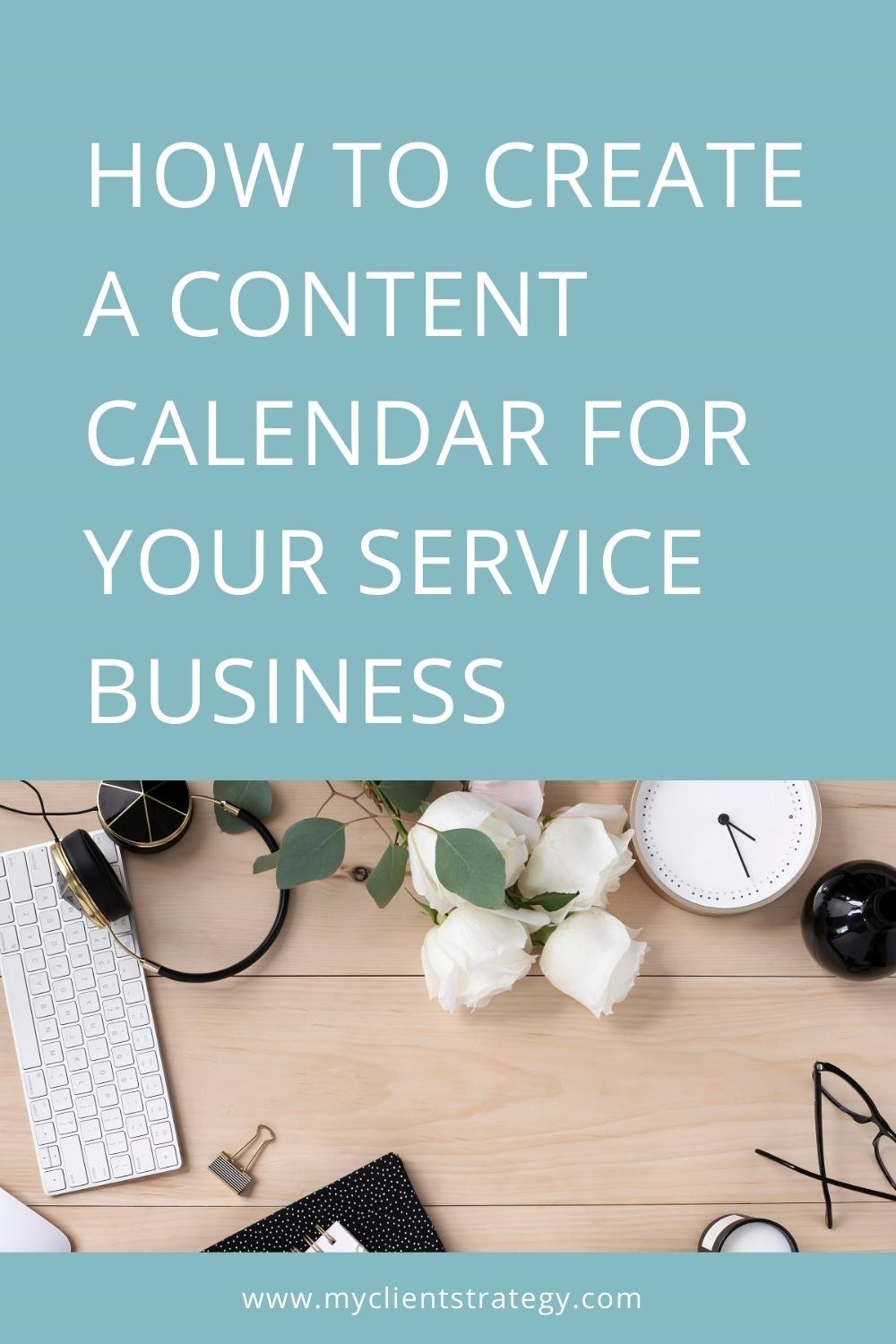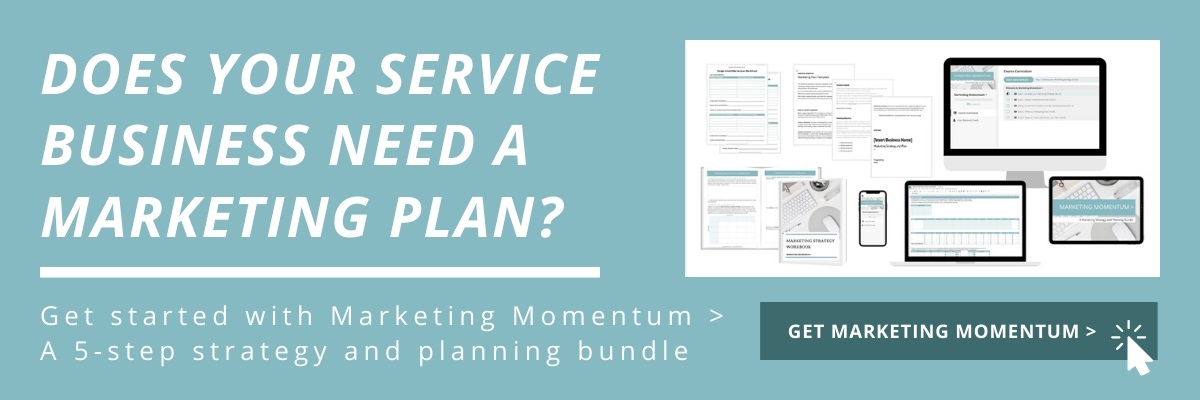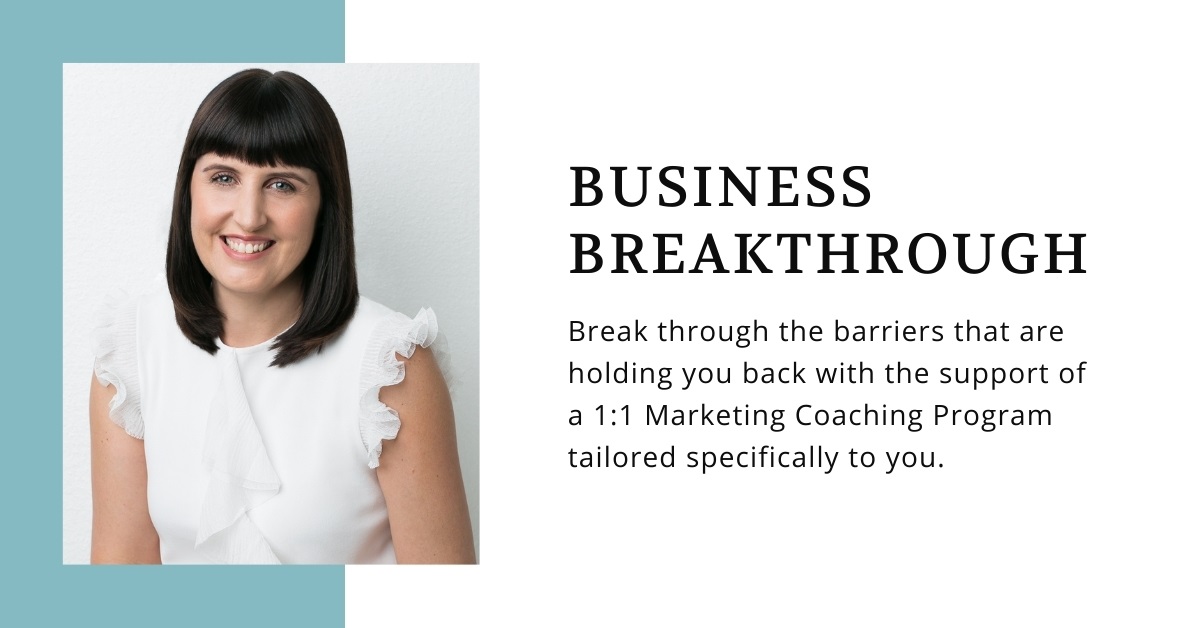How to create a content calendar for your service business

So, what is a content calendar, and how do you create one that’s effective for a service business?
A content calendar is a strategic schedule of the marketing content you plan to create and publish.
It will include a combination of content that provides value to your audience to build credibility and trust, and content that promotes your business and the services you sell.
Typically, a content calendar will include the following:
- The format or types of content you’ll create,
- The key topics that will feature in the content,
- The marketing channels where you’ll publish content, and
- The timing for when the content will appear.
A content calendar can also be referred to as a marketing calendar or a social media content calendar.
However, it’s important to note that a content calendar is NOT a complete marketing plan.
Instead, it’s only a part of your marketing plan and contains just the schedule of activities you’ll be implementing.

So, you may be wondering, how do you create an effective content calendar for a service-based business?
Firstly, the content within your marketing calendar must be closely related to the services you want to sell.
This approach will ensure that you’re attracting qualified leads from people who are most likely to become clients.
Also, a content calendar needs to strategically align to the key marketing objectives for your service business.
For example, your content needs to match any promotions or campaigns you’re running to grow.
So, if you were running a promotion to promote your signature service package, then the content you publish at that time needs to align to a topic that would resonate with the type of clients who would buy the service.
To help you get started with creating your content calendar, I’ve outlined five simple content planning steps for you to follow in the blog post below:
1. Choose the types of content you’ll create
I recommend choosing one primary type of core content to start with when it comes to content creation.
This content could be written, such as a blog. Or audio, such as a podcast. Or visual, such as a video series.
It’s much easier to create content when you play to your strengths, so choose a content format that you enjoy producing.
Also, consider what type of content your ideal clients may prefer or find easiest to consume.
For example, suppose you’re sharing something that is complex or technical.
It may be better to present it in a written or visual way instead of audio, where it could be challenging to understand.
Once you’ve chosen your core content, consider how this content could be re-purposed or re-produced in other formats.
As an example, could you re-use your core content (I.e. blog post) to publish social media posts about:
- Tips and Advice
- Tools and Resources
- Industry News
- Motivating or Inspirating Ideas
- Client Case Studies
In addition to the content that provides value for your audience, also consider how you can include your promotional content.
The type of content that’s effective in promoting a service business includes:
- Details about your Service Packages, Courses, or Programs
- Evidence of Experience and Skills
- Activities happening Behind-the-Scenes
- Promotions and Offers
- Client Testimonials
RELATED: 15 Types of content marketing you can use to stand out online
2. Decide on your content pillars (or topics)
Now that you’ve chosen what type of content you’re going to create, you’ll need to decide on the content pillars (topics) you’ll write or speak on.
To ensure that your content is structured and remains close to the niche that you specialise in, I recommend choosing 5 – 8 content pillars only.
To provide an example, if you were an Interior Designer, your content pillars might include things such as – Bathroom Design, Kitchen Design, Living Room Design, Colour Tips, Home Decorating, and Space Planning.
It may feel like your content will become repetitive and perhaps boring if you write or speak about the same things repeatedly.
However, this repetition is actually a good thing when it comes to marketing.
You’ll become more memorable by repeatedly talking or writing about the same topics, and you’ll be positioning yourself as an expert in your niche.
The Google search engine will also start to recognise that your website contains in-depth content on a particular niche area which will help your search engine ranking.
RELATED: How to write a content marketing plan for a service business
3. Identify the best marketing channels to publish your content
If you’ve decided to create a blog, your website is the best place to publish this content.
Because each time you add a blog to your site, you’re adding more SEO keywords and increasing the likelihood of your website being found by your ideal clients.
Each time you add a blog to your site, you're adding more SEO keywords and increasing the likelihood of your website being found by your ideal clients. #seomarketing #blogging Share on XYou may also want to consider some other blogging platforms from time to time to increase your reach.
These other platforms could include media publishing sites or referral partner sites where you could get featured as a guest author/blogger.
If you’ve produced a video series, you’ll likely want to publish this on your website and YouTube to maximise your reach.
And if you’ve produced a podcast, you’ll want your episode show notes also published on your website.
And on the Spotify and Apple platforms, as they already have an audience there searching for podcasts to listen to.
Once you’ve decided on your main content channel, consider what other marketing channels you have available to reach your audience.
These marketing channels could include your email list and the various social media platforms where you have a following.

4. Map out the timing for publishing content
To begin with, I recommend preparing your content schedule in a 90-day block, as this is a standard timeframe used by many marketers.
It provides you with a forward view of what’s coming up but is not too long that it doesn’t enable you some flexibility to adapt and adjust if you need to, based on the results you achieve.
There are various ways to map out your content calendar and several tools you can use to make the process easier.
You can start with something as simple as an excel spreadsheet or use an online productivity tool like Asana or Trello.
To keep things simple, in the steps below, I explain how to set up your content calendar in an excel spreadsheet:
Part 1 – Your content strategy:
- In the first column, give it a heading of DATE, and list the week commencing date for each week (you should have 13 rows for the 13 weeks).
- In the second column, give it a heading of SERVICE FOCUS, and list the service you want to focus on selling each week (this will also be your primary call to action). You may want to focus on one type of service each month, or perhaps you have a focus on the same service for a more extended period in the lead up to a launch.
TIP: If you have clarity and focus on the type of service you want to sell, you’ll be more likely to see greater success. - In the third column, give it a heading of PROMOTIONS, and enter the details for when you are running any marketing campaigns, launches, or promotions during the 90 days.
TIP: Only run one promotion in your business at a time, so your message is not diluted with multiple offers at once. - In the fourth column, give it a heading of CONTENT PILLAR, and enter the key topic or theme for each week. Be sure to align the content topic to support your promotional activity. You may wish to run one content topic per month or every 4-6 weeks based on what’s most relevant.
- In the fifth column, give it a heading of CORE CONTENT, and list the titles for any blogs/podcasts/videos you will be releasing during the period. The number will depend on what capacity you have. I recommend, at a minimum, you have at least one new core piece of content each month. Or, if you want to grow your business sooner, then release one new piece of core content (I.e. a blog post or podcast episode) every week.
Part 2 – Your detailed content calendar:
- In a new sheet (or the same sheet below), list the dates in the first column for each of the 90 days.
- Next, enter your weekly core content focus (from above) against the relevant dates in the second column.
- In the third and subsequent columns, along the top, create headings for each marketing channel you have. For example, in column three, you may have an email list. In column four, you have Instagram posts. And column five, you have Instagram stories etc.
- Finally, fill in the cells with the content you will create each day and share across your marketing channels. Refer to the list of content types and topics that you mapped out in steps one and two above. And keep in mind that you can share the same content on multiple channels, so you don’t need to come up with unique content for every post.
I also have a few tips and points to note with this final step:
- You won’t have something in every single cell of your content calendar, as you won’t be emailing your list every day and probably won’t be posting on every social media channel each day either. So, focus only on filling in the content calendar with the content you have the capacity to create.
- One way to easily schedule the content is to pick a type of content and align it to the day of the week. For example, choose a regular day of the week when you will publish your blog (i.e. Wednesdays) and a set day when you will send emails to your list (i.e. Thursdays). This approach creates a pattern and a rhythm that will make it easier for you to stick to.
Not sure where to start when it comes to marketing your service-based small business? That’s where I can help. Get started by downloading my free Ultimate Marketing Checklist by clicking the button below:
5. Measure, track and review your content performance
The last stage in creating your content calendar is to continuously look at your insights and data to inform you on what to publish.
If you notice a specific type of post that gets lots of engagement, try to create similar content.
Your content calendar will continuously evolve as your business grows and you capture more insights to inform your content strategy.
So, there you have my simple step-by-step process for creating an effective content calendar for your service business.
When you follow these steps, your content calendar will be created strategically and align more closely with your business goals.
A strategic content calendar will also help you improve the overall effectiveness of your marketing campaigns and activities.
Tired of trying to figure out what you’re missing when it comes to finding clients and making sales in your service business?
Break through the barriers that are holding you back with the support of an MBA-qualified Marketing Coach and Business Mentor who will tailor a 1:1 program specifically for you.

BUSINESS BREAKTHROUGH is a 3 or 6-month 1:1 Coaching Program for service-based business owners who want to develop the strategy, systems, and structure they need to find clients and make sales, so they can stop feeling stuck and start gaining massive momentum in their business.
Did you find this blog post helpful? Don’t forget to PIN to Pinterest and share on Facebook.



